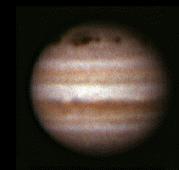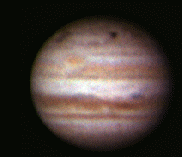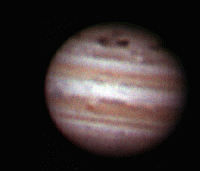

Some of the best images of Jupiter taken using slide film are shown here. All images are shown inverted, with South on top and West on the right side. They all used the AO-2 adaptive optics system, and show nearly diffraction-limited images taken during moderately good seeing in San Diego, but when the planet was rather low in the sky. All of these images were taken with a 10" F/10 telescope, projected to F/140 with an eyepiece projection setup and a Minolta SRT-101 body. Fuji Velvia film was chosen; it has a relatively slow speed of ISO 50, but I think it has the best contrast and the finest grain of any of the slide films. To digitize the images, the slides were re-imaged using red, green, or blue light onto a CCD camera. Each individual exposure was gently processed with Berry's AIP program (unsharp masked), then merged with Johnston's Super-Tri program. The intent of the image processing was to keep as much detail as possible without distortion. The colors shown here are as realistic as possible! Since several steps were required to digitize the film, and then do flat-field processing on those images, and finally merge the images, they are only a fair representation of the original slides. The re-photographing of the slides brought out more grain, but since they were taken during a unique time in Jupiter's history, they are all shared here.

Jupiter at 4:18 UT on July 22, 1994; a 28 second exposure. The largest impact areas are seen with lighter areas surrounding them. Some image deterioration is from the copying process from the slide to the digital format.

Jupiter at 4:27 UT on July 25, 1994; a 25 second exposure. The Great Red Spot is visible, for a good size comparison. Jupiter's central meridian was nearly the same as for the June 19 photos, which makes a good before-and-after comparison. Note the bright blue clouds near the center, making interesting contrasts.

Jupiter at 4:18 UT on July 26, 1996. With the other two images, this set shows all the major impact areas. The AO-2 allowed these great images to be taken even though the seeing was poor so close to the horizon.
All text and images are owned by Stellar Products, 1992-2003. Any use by others without permission of Stellar Products is prohibited.
Links to other Stellar Products pages:
Stellar Products Image Gallery